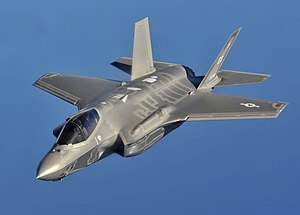| F-35 Lightning II | |
|---|---|

| |
| F-35A Lightning II | |
| Role | Stealth multirole fighter |
| National origin | United States |
| Manufacturer | Lockheed Martin Aeronautics |
| First flight | 15 December 2006 (F-35A) |
| Introduction | F-35B: 31 July 2015 (USMC)[1][2][3] F-35A: 2 August 2016 (USAF)[4] F-35C: 2018 (USN)[5] |
| Status | In service |
| Developed from | Lockheed Martin X-35 |
Lockheed Martin F-35 Lightning II development started in 1995 with the origins of the Joint Strike Fighter program and culminated in the completion of operational testing and start of full-rate production in 2021.[6] The X-35 first flew on 24 October 2000 and the F-35A on 15 December 2006.
The F-35 was developed to replace most US fighter jets with variants of one design common to all branches of the military. It was developed in cooperation with a number of foreign partners, and unlike the Lockheed Martin F-22 Raptor, is intended to be available for export. Three variants were designed: the F-35A (conventional take off and landing, CTOL), the F-35B (short-take off and vertical-landing, STOVL), and the F-35C (carrier-based catapult assisted take-off (CATOBAR), CV). Despite being intended to share most of their parts to reduce costs and improve maintenance logistics, by 2017 the design commonality was only 20%.[7]
The program received considerable criticism for cost overruns during development and for the total projected cost of the program over the lifetime of the jets. By 2017 the program was expected over its lifetime (until 2070) to cost $406.5 billion for acquisition of the jets and $1.1 trillion for operations and maintenance.[8] A number of design deficiencies were alleged, such as carrying a small internal payload, inferior performance to the aircraft being replaced, particularly the General Dynamics F-16 Fighting Falcon, and the lack of safety in relying on a single engine, and flaws were noted such as vulnerability of the fuel tank to fire and the propensity for transonic roll-off (TRO or "wing drop"). The possible obsolescence of stealth technology was also criticized.
- ^ Story, Courtesy (31 July 2015). "U.S. Marines Corps declares the F-35B operational". www.marines.mil. Headquarters Marine Corps. Retrieved 31 July 2015.
- ^ "US Marines stick to F-35B dates despite new problems". flightglobal.com. Reed Business Information Limited. Retrieved 25 May 2015.
- ^ "F-35B on track for operational readiness despite software challenges". janes.com. Archived from the original on 29 April 2015. Retrieved 25 May 2015.
- ^ "U.S. Air Force eyes future F-35 engine and arms upgrades". Reuters. 7 April 2015. Retrieved 25 May 2015.
- ^ "The Current Status of the F-35, in Three Charts". Intercepts – Defense News. Archived from the original on 2014-10-02. Retrieved 2017-08-18.
- ^ F-35 Program Information – Non Export Controlled Information Archived 2014-02-21 at the Wayback Machine Keith P. Knotts, 9 July 2013
- ^ Barrett, Paul (April 10, 2017). "Danger Zone". Bloomberg Businessweek. pp. 50–55..
- ^ "F-35 Program Costs Jump to $406.5 Billion in Latest Estimate". Bloomberg.com. Bloomberg. 10 July 2017.
